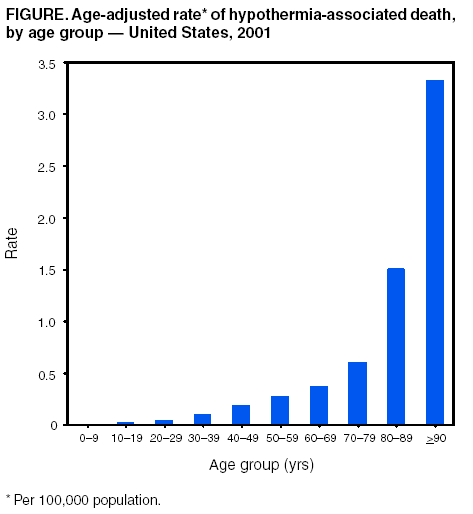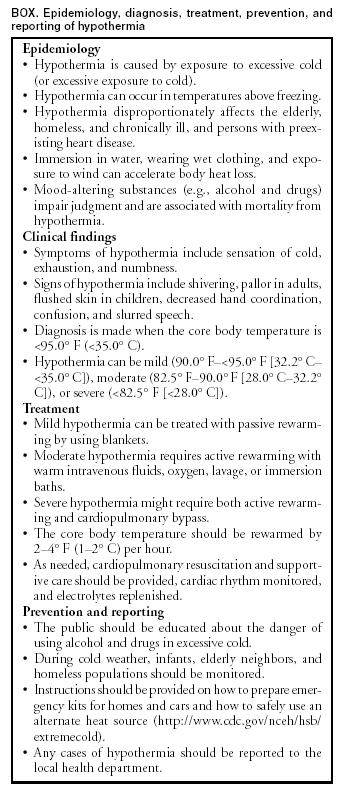 |
|
|
|
|
|
|
| ||||||||||
|
|
|
|
|
|
|
||||
| ||||||||||
|
|
|
|
|
Persons using assistive technology might not be able to fully access information in this file. For assistance, please send e-mail to: mmwrq@cdc.gov. Type 508 Accommodation and the title of the report in the subject line of e-mail. Hypothermia-Related Deaths --- United States, 2003Hypothermia, a preventable lowering of the core body temperature to <95° F (<35° C) (1), causes approximately 600 deaths each year in the United States (2). Exposure to excessive cold (or excessive exposure to cold) slows enzymatic activity throughout the body, leading to potentially fatal rhabdomyolysis, coagulopathy, renal failure, and dysrhythmias (3). Alcohol intake, activity level, and type of clothing are among the modifiable factors associated with hypothermia (4). Understanding the epidemiology and pathophysiology of hypothermia is important to preventing hypothermia-related mortality. This report describes three cases of fatal hypothermia that occurred during 2003, reviews national statistics on mortality from cold exposure in 2001, and provides recommendations for the diagnosis, treatment, and prevention of hypothermia. Public health strategies tailored to U.S. populations at increased risk for exposure to excessive cold can help reduce mortality and morbidity from hypothermia. Case ReportsCase 1. In the fall of 2003, a man aged 44 years was found dead outdoors in Vermont. He wore a T-shirt, long-sleeved shirt, two sweatshirts, underpants, pants, socks, and boots. His clothes were wet, and an empty vodka bottle was nearby. Local investigators reported that he looked as though he "lay down and went to sleep." Overnight, the temperature had dropped to <32° F (<0° C). Autopsy findings were unremarkable except for a fatty liver. A toxicology screen was negative except for an elevated blood alcohol concentration (BAC) of 0.30 g/dL, nearly four times the legal intoxication limit of 0.08 g/dL in Vermont. Cause of death was certified as hypothermia, with alcohol intoxication as a contributing factor. Case 2. In the spring of 2003, a man aged 76 years with Alzheimer's disease was reported missing from his home in Vermont. The next day, a farmer found the man lying in a swampy area where his car had become stuck in the mud. Overnight, the temperature had dropped to <32° F (<0° C). The man was pronounced dead at the scene; cause of death was hypothermia precipitated by a cold, wet environment. Case 3. In the fall of 2003, Alaska state troopers reported that a hiker aged 35 years was found dead alongside a highway. The hiker was not clothed from the waist up and was missing a shoe. The overnight temperature was 44° F (6.7° C), but conditions were wet and windy. The hiker's BAC was 0.28 g/dL, nearly four times the legal intoxication limit of 0.08 g/dL in Alaska; his toxicology screen was positive for cocaine and marijuana. Cause of death was hypothermia, with drug and alcohol intoxication as contributing factors. United StatesIn the United States, certain populations (e.g., alcoholics; drug users; elderly, homeless, and chronically ill persons; and those with preexisting heart disease) are at increased risk for dying from hypothermia. During 2001, a total of 599 persons in the United States (2) died from "exposure to excessive natural cold" (code X31), as categorized in the International Classification of Diseases, Tenth Revision. Of these victims, 67% were male, and 51% were aged >65 years. As persons age, their risk for dying from hypothermia increases (Figure). Approximately 71% of the hypothermia-related deaths in 2001 occurred during November--February. The three states with the highest rates of death from hypothermia were Montana (1.44 persons per 100,000 population), Alaska (1.42), and New Mexico (1.04). Reported by: S Shapiro, MD, P Morrow, MD, Vermont Dept of Health. F Fallico, MD, Alaska Dept of Health and Social Svcs. E Azziz Baumgartner, MD, EIS Officer, CDC. Editorial Note:Hypothermia causes multiple dysfunctions, including cardiac arrhythmias, renal insufficiency, and hemoconcentration. In late stages of hypothermia, brain function deteriorates, predisposing persons to poor judgment and increasing their risk for further exposure to excessive cold. Improper clothing and comorbidities can interfere with the balance between the body's heat production and cooling. Wet clothing cannot retain body heat; warm clothing keeps the body dry and helps to decrease heat loss, which can save a person's life during excessively cold weather. Advanced age, immobility, and existing medical conditions can increase the risk for hypothermia and death during cold weather. Certain medical conditions (e.g., hypothyroidism, congestive heart failure, and diabetes) can affect a person's ability to recognize warning symptoms of hypothermia, compensate for the cold, or to seek shelter from the cold. Use of alcohol or other mood-altering drugs often is associated with cases of hypothermia. The vasodilatation caused by alcohol provides a sensation of warmth but also increases heat loss through radiation. In addition, alcohol and other drugs impair hand coordination, mobility, and decision-making abilities. Treatment of hypothermia focuses on returning the core body temperature to normal while providing supportive care. The method chosen to rewarm a patient depends on the severity of the hypothermia (Box. With rewarming and supportive care, even persons who appear to be dead might survive hypothermia (5). Prevention of hypothermia requires public health strategies that target persons at greatest risk. Such strategies can include creating community programs for checking on the well-being of elderly persons, opening temporary shelters for the homeless, and urging persons with cardiovascular disease to avoid outdoor exercise during cold weather (6). References
Figure  Return to top. Box  Return to top.
Disclaimer All MMWR HTML versions of articles are electronic conversions from ASCII text into HTML. This conversion may have resulted in character translation or format errors in the HTML version. Users should not rely on this HTML document, but are referred to the electronic PDF version and/or the original MMWR paper copy for the official text, figures, and tables. An original paper copy of this issue can be obtained from the Superintendent of Documents, U.S. Government Printing Office (GPO), Washington, DC 20402-9371; telephone: (202) 512-1800. Contact GPO for current prices. **Questions or messages regarding errors in formatting should be addressed to mmwrq@cdc.gov.Page converted: 3/4/2004 |
|||||||||
This page last reviewed 3/4/2004
|